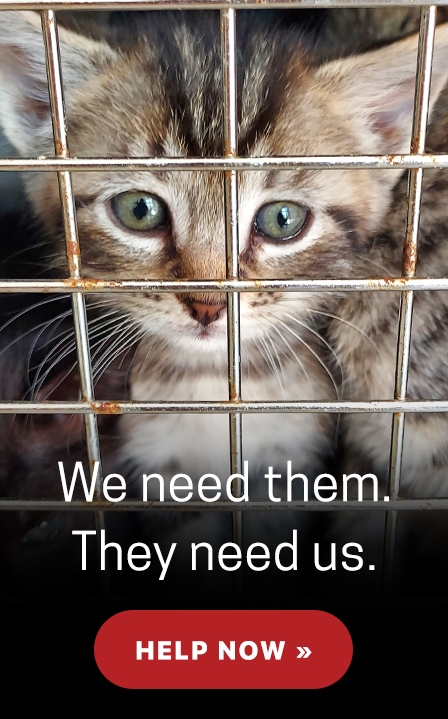WASHINGTON, DISTRICT OF COLUMBIA, September 12, 2018 — Seventy-two beautiful cats and kittens are safe and sound from nature’s fury today after being evacuated from shelters in the path of monster hurricane Florence by the national American Humane Rescue team. The animals are part of the first wave of rescues in advance of what is predicted to be a potentially catastrophic storm. The American Humane Rescue team, which has been saving animals in disasters for more than 100 years, rushed to pick up dozens and dozens of vulnerable pets at shelters in South Carolina and drove them more than 800 miles to safe havens in New York and Connecticut where they can find lifesaving refuge from the storm and, just as important, find forever homes.
American Humane continues to coordinate with and reach out to shelters and municipalities to meet the coming need, and with millions in the storm path, is working to prepare the public to keep themselves and their pets safe. American Humane President and CEO Dr. Robin Ganzert, who had to evacuate with her own dog Daisy from her South Carolina home, is working with the national media to disseminate critical, life-saving tips, including this expert advice on what to do before, during and after the storm:
BEFORE THE STORM
- Microchip pets or put a tag on their collar with your name, address and cell phone number so they may be returned quickly in case you are separated from your pets. Be sure that any microchip information is up-to-date.
- Tie down or anchor outside objects that might fly about and injure someone.
- Know a safe place where your pets can go if you need to evacuate or seek shelter. Evacuation destinations may include a friend or family member’s home, going to a pet-friendly hotel, or temporarily housing your pet(s) at a boarding facility. Plan multiple routes to your safe destination. Review your evacuation plan and double-check emergency supplies – including bowls, water and food.
- Evacuate your family and pets as early as you can and remember to take your disaster preparedness kit for your pets (i.e. First Aid kit, leashes, and pets’ carrying cases, bowls, sanitation materials, chew toy, minimum 3 days, ideally 7-10 days of food, meds, water, your veterinarian’s contact information, a photo of your pet).
- Bring pets inside; bring outdoor animals inside with a carrier ready large enough to turn around and lie down comfortably.
- Have a carrier at the ready. The portable carriers(s) should be large enough for your pets to stand-up and turn around in ready to go at a moment’s notice. Practice loading cats and dogs in pet carriers before you have to.
- If your family must evacuate, take your pets with you.
DURING THE STORM…IF YOU CANNOT EVACUATE
- Choose a safe room for riding out the storm—an interior room without windows – and take your entire family there, including your pets.
- Stay with pets. If crated, they depend on you for food and water. Don’t leave pets in vehicles.
- Keep your emergency kit in that room with you (food, water, litter, meds, etc).
- Know your pet’s hiding places. That’s where they may run; keep them with you.
- Secure exits and cat doors so pets can’t escape into the storm.
- Do not tranquilize your pets. They’ll need their survival instincts should the storm require that.
AFTER THE STORM
- Make sure the storm has fully passed before going outside and assess damages before allowing children or animals out.
- Keep dogs on a leash and cats in a carrier, and children close at hand. Displaced objects and fallen trees can disorient pets and sharp debris could harm them.
- Give pets time to become re-oriented. Familiar scents and landmarks may be altered and cause a pet to become confused or lost.
- Keep animals away from downed power lines and water that may be contaminated.
- Uncertainty and change in the environment affect animals, too, presenting new stresses and dangers. Your pet’s behavior may change after a crisis, becoming more aggressive or self-protective. Be sensitive to these changes and keep more room between them, other animals, children or strangers. Animals need comforting, too. Comfort your pet with kind words and lots of pats or hugs. If possible, provide a safe and quiet environment, even if it is not their own home.
To make a donation towards our disaster relief efforts, click here.
About the American Humane Rescue program
American Humane is the country’s first national humane organization, founded in 1877. The American Humane Rescue program has been involved in nearly every major relief effort over the past 100 years, including World War I when we rescued wounded horses on the battlefields of Europe, the Great Ohio Flood of 1937, Pearl Harbor, Hurricane Katrina, the terror attacks on 9/11, the Japanese earthquake, tsunami and nuclear disaster, Superstorm Sandy, the killer tornadoes in Joplin and Oklahoma, the Louisiana and West Virginia floods, the Tennessee wildfires, and most recently, Hurricane Harvey in Texas and Hurricane Irma in Florida.
About American Humane
American Humane is the country’s first national humane organization, founded in 1877. For more information, please visit www.americanhumane.org.

